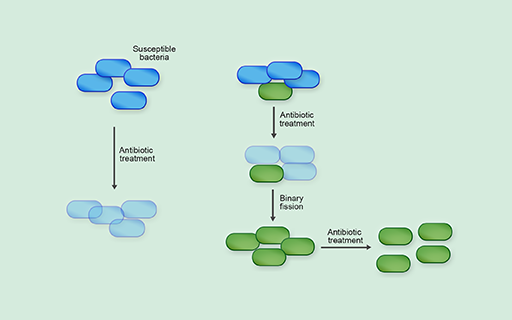3.2 Evolving resistance to antibiotics
How do bacteria evolve resistance to antibiotics? Activity 3 will help you to think about how evolution and natural selection contribute to the spread of antibiotic resistance.
Activity 3 Evolution, natural selection and antibiotic resistance
Darwin’s theory was that evolution by natural selection would occur if the following conditions were met:
- There is a struggle for existence. Survival is limited by environmental constraints, so that there is competition, and not all individuals will survive to produce offspring.
- There is variation between individuals. Individuals with advantageous traits will have a greater probability of survival under these conditions and are therefore more likely to reproduce.
- The characteristics, or traits, of an individual are inherited. Advantageous traits that promote survival will be inherited by the next generation so that these traits become increasingly common in the population.
Now answer the following questions about the evolution of antibiotic resistance.
a.
(a) low nutrient supply
b.
(b) presence of antibiotics
c.
(c) low oxygen availability
d.
(d) all of the above
The correct answer is d.
d.
Your answer is correct. Any of these could conditions could create a struggle for existence that could lead to the evolution of antibiotic resistance.
a.
(a) Antibiotic resistance would be advantageous.
b.
(b) Antibiotic resistance would be disadvantageous.
c.
(c) Antibiotic resistance would have no effect on the survival of bacteria growing in the presence of antibiotics.
The correct answer is a.
a.
Your answer is correct. Antibiotic resistance would be an advantageous trait in the presence of antibiotics because resistant bacteria in the population will have a survival advantage over sensitive bacteria. However, in the absence of antibiotics, resistance can sometimes be disadvantageous because it can result in slower growth.
a.
(a) horizontal gene transfer
b.
(b) transformation
c.
(c) binary fission
d.
(d) genetic mutation
The correct answer is c.
c.
Your answer is correct. Antibiotic resistance genes, acquired via genetic mutation or horizontal gene transfer, can be inherited by subsequent generations through binary fission.
Within a bacterial population, some bacteria will be sensitive to antibiotic treatment while others will have acquired resistance to antibiotics, via either genetic mutation or horizontal gene transfer. In the presence of antibiotics, the resistant bacteria have a survival advantage over the sensitive bacteria and are more likely to survive and reproduce. Because bacteria reproduce so quickly, resistant bacteria can quickly dominate the population (Figure 10).

Of course, changes to the bacteria’s environment made by us can affect the evolution of antibiotic resistance. You will return to this theme when you look at how our use of antibiotics contributes to the rise of antibiotic resistance bacteria in Week 5.
